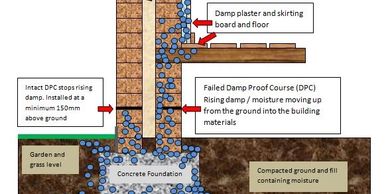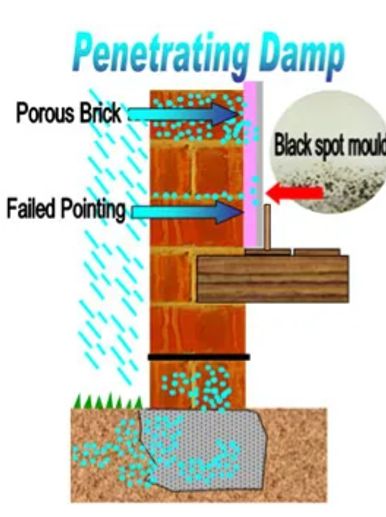Common Damp and Timber Issues
Rising Damp
Penetrating Damp
Penetrating Damp

Rising damp is a type of damp which can impact the lower portion of walls on the ground floor of properties. Accurate diagnosis and the necessary remedial work being carried out swiftly are very important when dealing with a rising damp issue.
Rising damp is the upwards flow of water through wall structures. The moisture is sucked from the ground at the base of the wall of your property. Through capillary action, the water rises through the tiny pores in the masonry and travels up through the wall.
Ground water contains salts which are carried through the water which is travelling through the wall. These will be left behind even after the water has evaporated.
Although rising damp can usually only reach a height of around 1 metre up the wall, salt deposits may be visible higher up. This is due to the evaporation process affected by different wall finishes or the environment at the wall. Damp treatment in Colchester, Ipswich, Chelmsford and surrounding areas.
Penetrating Damp
Penetrating Damp
Penetrating Damp

Penetrating damp is the process of moisture being built up horizontally through the external walls of the building into the property.
Often misdiagnosed as rising damp, penetrating damp can lead to further, more serious issues such as wood rot, increased heat loss, frost damage into masonry and unsightly water damage on both the outside and inside of a property. Colchester Ipswich Chelmsford and surrounding areas.
Condensation
Penetrating Damp
Condensation
Condensation occurs when moist air comes into contact with a colder surface like a wall, window, mirror etc. The air can’t hold the moisture and tiny drops of water appear. It also occurs in places the air is still, like the corners of rooms, behind furniture or inside wardrobes.
Dry Rot
Beetle Infestation
Condensation

Dry rot is a type of fungal timber decay known as Serpula Lacrymans. It occurs when wood becomes too wet with a moisture content of over 20% and the wood-destroying fungus attacks the timber.
Dry rot is the most serious form of fungal decay. Dry rot fungus is very destructive as it spreads across masonry and destroys all timber in its path including structural timbers, skirting boards, door frames, and flooring. It affects all types of properties, new and old, and can be detrimental to a property if left untreated as the fungus can weaken the structural integrity of a building and cause it to collapse.
Wet Rot
Beetle Infestation
Beetle Infestation

Wet rot is the natural decay of timber due to high moisture levels. It occurs in timber with a moisture content of around 30%-50%.
Wet rot is caused by a fungus that is attracted to very damp wood and feeds off the timber, destroying it in the process. There are many different types of fungus, but Coniophora puteana, also called cellar fungus, is the most common.
Wet rot is confined to a localised damp area and does not spread, making it less destructive than dry rot. However, wet rot can be just as destructive as dry rot, and, if left untreated, can seriously weaken structural timbers and lead to major structural damage.
Beetle Infestation
Beetle Infestation
Beetle Infestation

The most common type of beetle found within the home is the common furniture beetle which infests softwoods. This wood boring insect can be found in most properties across the UK. This beetle does not cause structural damage however, it does consume the sap wood edges.
The female insect lays the eggs inside the cracks of the timber and these will hatch within a few weeks. The larva will mature into a woodworm beetle over 3-4 years boring its way through the wood.
The Deathwatch Beetle is the 2nd most common infestation in the UK. This is one of the worst wood boring beetles that can affect your property. Deathwatch beetles attack timbers that have a moisture content of over 14%.
Aquacure Damp and Timber Limited
Mill Road, West Mersea, Colchester, CO5 8RH, United Kingdom
Copyright © 2024 Aquacure Damp and Timber Limited - All Rights Reserved.
Powered by GoDaddy